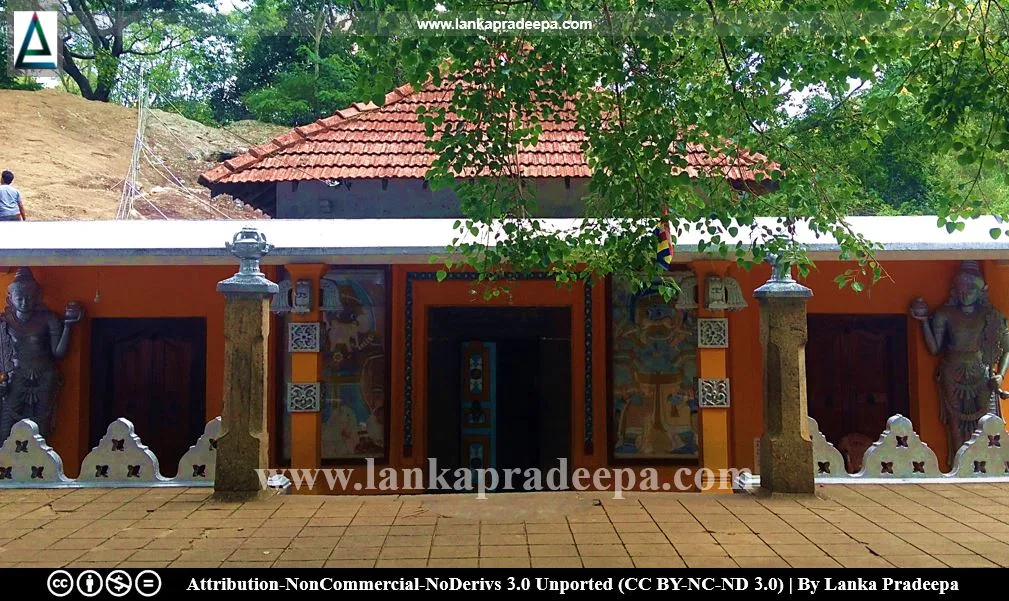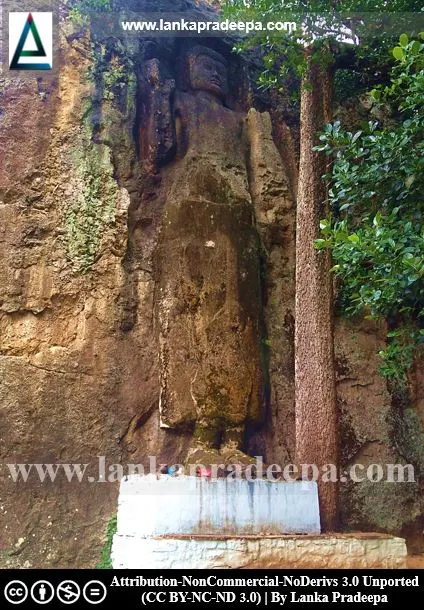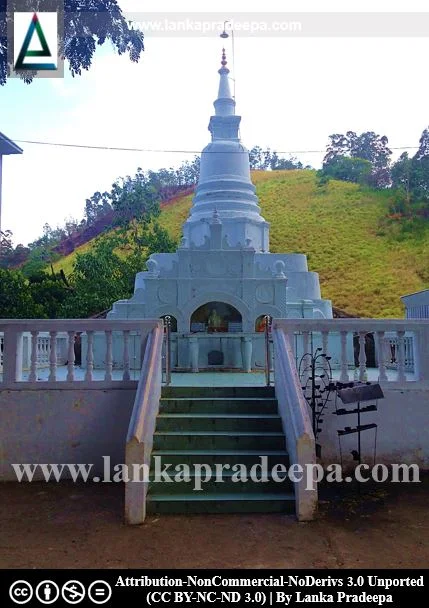
Dowa Raja Maha Viharaya (Sinhala: දෝව රජ මහා විහාරය) is an ancient Buddhist temple located in the village of Dowa in Badulla District, Sri Lanka. The site can be reached by travelling along the Bandarawela - Badulla road about 6 km distance from Bandarawela town. Presently, the travellers on vehicles stop and make some offerings to the small wayside Siamese-type Stupa and the Bodhi tree of this temple as a custom.
History
As is evidenced by the huge and partially carved Buddha statue at the temple, the history of Dowa Viharaya goes back to at least the latter half of the Anuradhapura Period probably to the 9th or 10th century (Chutiwongs et al., 1990). However, without concrete evidence, locals have inclined to believe that this statue is a work belonging to the reign of King Valagamba [(103 B.C. and c. 89–77 B.C.) De Jayawardena, 2015].
The Len Viharaya (the cave temple) which underwent structural expansions during the Kandyan Period may have been a resort for forest-dwelling monks in ancient times (Chutiwongs et al., 1990). The paintings and sculptures in several chambers within the present shrine show evidence that it has gone through several stages of development (Chutiwongs et al., 1990). The temple may have attracted the patronage of King Kirti Sri Rajasinha (1747-1781 A.D.) of Kandy and the inscription above the shrine's doorway giving the date as 1880 possibly indicate the time when the two large figures of Siva Aghora and Siva Vatuka were painted on the two sides of the entrance (Chutiwongs et al., 1990).
The paintings on the walls of the vestibule of the Buddha shrine were done in the 1940s by renowned painter M. Sarlis [(1875-1955) Chutiwongs et al., 1990].
The temple
The temple is located by the wayside on a terraced hill slope with a stream running as the boundary on the east side. A small Thorana parallel to those seen in front of Kelaniya Viharaya is found at the entrance to the temple ground. A steep verticle face of a rock boulder about 18 m high which is to the south of the image house has been cut to sculpt a standing Buddha statue about 11 m (36 ft.) in height (Chutiwongs et al., 1990; Priyadarshani & Gunasena, 2017). The natural rock cave at the site has been utilized as part of the Buddha shrine and the old Bodhi tree is directly located in front of this shrine (Chutiwongs et al., 1990).
A small Stupa about 10 ft. in height is found at the rear part of the image house. A tunnel mouth that has been closed today is also found aside from the Stupa. The cave is about 15 ft. in height and about 5 ft. in width (Priyadarshani & Gunasena, 2017). It is believed that this tunnel may have been used in ancient times by the royal people for their safe journeys (Priyadarshani & Gunasena, 2017). According to some, this tunnel connects with nearby Bogoda Viharaya, Ravana Cave and Rakkhithakanda Temple.
Buddha Statue

The Buddha statue which is incompletely sculpted in high relief on the vertical face of the rock boulder is believed to have been erected during the reign of King Valagamba in the 1st century B.C. Depending on these local beliefs, some authors such as de. Jayawardena, point out that this statue could be the oldest statue in Sri Lanka (De Jayawardena, 2015). However, scholars are of the opinion that this statue is a work datable to about the 9th or the 10th century (Chutiwongs et al., 1990).
According to scholars, the Dowa Buddha statue belongs to the same category of such images as at Buduruwagala, Sesseruwa and Avukana (Chutiwongs et al., 1990).
Image House
The image house located at the lowest terrace of the temple can be identified as the main monument of archaeological interest. The original image house has been positioned under an overhanging rock with a small Stupa inside the drip-ledged cave at the further end (Chutiwongs et al., 1990). With all the modern additions, the present image house consists of several chambers, viz; the front hall, the antechamber and the cella.
On both sides of the main entrance to the front hall of the image house, panels showing the figures of the fierce aspects of the Hindu god Siva, namely, Aghora to the west and Vatuka to the east are found (Chutiwongs et al., 1990; Priyadarshani & Gunasena, 2017). These two figures show similarities in style to the same pair found in Gangarama Viharaya (Chutiwongs et al., 1990). The inner walls of the front hall are filled with paintings depicting the heaven and hell scenes and the Jataka stories of Buddha such as Vessantara, Telapatta, Culladammapala, etc. (Chutiwongs et al., 1990; Priyadarshani & Gunasena, 2017). The ceiling is decorated with various motifs including nine planetary deities and twelve zodiac signs.
On the inner walls of the antechamber are murals and sculptures depicting the Suvisi Vivaranaya (Buddha to be receiving the blessing from 24 previous Buddhas). On the ceiling, the figures of a row of forty-six Arhats holding flowers, designs of rosettes and lotus medallions and the painting called Gaja-vrsabha or Ath-Gon Satana (battle between a tusker and a bull) are found.
A recumbent Buddha image under the overhanging rock facing the main entrance, is in the cella, on the north wall. The west wall also accommodates a reclining Buddha statue while the south wall supports another Buddha image. Other walls are filled with murals showing the figures of Arhats, Ganesha, Vibhishana with his horse and Saman with his elephant and the images of Kataragama and Visnu (Chutiwongs et al., 1990). In general, the traditional-style paintings found in the Dowa shrine show similarities to the paintings in Randombe Sangharaja Viharaya, Kottimbulvala Viharaya and Devinuwara Viharaya (Chutiwongs et al., 1990). A series of copied murals of the Kelaniya Viharaya paintings by Solias Mendis are found on the walls of the ambulatory of the shrine (Chutiwongs et al., 1990).
A protected site
The image house with ancient paintings, ancient Stupa and the statue on the slab of rock in the premises of Dova Raja Maha Vihara in Dova village in the Grama Niladhari Division No. 69-D of Dova in Ella Divisional Sectetary’s Division are archaeological protected monuments, declared by two government gazette notification published on 1 November 1996 and 1 June 2023.



 .
.
References
1) Chutiwongs, N.; Prematilleke, L.; Silva, R., 1990. Sri Lanka Bithu Sithuwam: Dova (Paintings of Sri Lanka: Dova). Archaeological Survey of Sri Lanka: Centenary publication. Central Cultural Fund. ISBN: 955-613-008-X. pp.37-47.
2) De Jayawardena, U.S., 2015. A Study on the present states of different
rocks of ancient monuments in Sri Lanka. G. Lollino et al. (eds.), Engineering Geology for Society and Territory–Volume 8. Springer International Publishing Switzerland. pp. 43-46.
3) Priyadarshani, S.A.N.; Gunasena, I.P.P., 2017. Pauranika Sthana Ha Smaraka: Badulla Distrikkaya (In Sinhala). Department of Archaeology. ISBN: 955-9159-48-8. pp.16-18.
4) The Gazette of the Democratic Socialist Republic of Sri Lanka. No: 948. 1 November 1996.
4) The Gazette of the Democratic Socialist Republic of Sri Lanka. No: 948. 1 November 1996.
5) The Gazette of the Democratic Socialist Republic of Sri Lanka; Extraordinary. No: 2334/41. 1 June 2023. p.4A.
Explore Other Nearby Attractions
Location Map (Google)
This page was last updated on 3 December 2023

